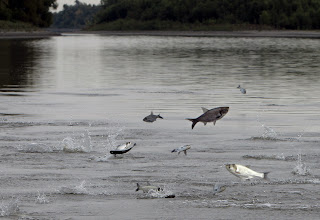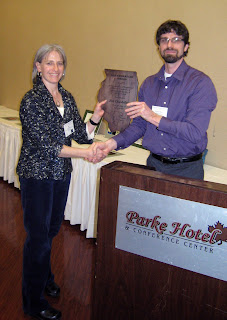May 28th, 2013 by Irene Miles
Dozens of Michigan teachers were some of the attendees at the 2013 Great Lakes Conference at Michigan State University back in March, and one of the most important topics of discussion was the current and future need for improving Great Lakes literacy.
From the MSU office of extension:
“At the luncheon, educators learned about upcoming professional development opportunities relating to the Great Lakes, and shared their best practices in Great Lakes education, as well as their priority needs relating to advancing Great Lakes literacy in the classroom.
So with the goal of advancing Great Lakes literacy in mind, what were some of their best practices and needs that emerged from the teacher discussion? The best practices clustered around five themes: 1) curriculum, 2) place-based education, 3) data in the classroom, 4) hands-on learning, and 5) cross-curriculum lessons…”
Follow the link above to read the complete article, including links to further information for educators.
May 3rd, 2013 by Irene Miles
Meredith Brackett, one of Illinois-Indiana Sea Grant’s interns this past summer, has continued her work on Great Lakes issues by starting a position at Oak Ridge Institute of Science and Education. She wrote in to tell us a little bit about her summer internship experience working with IISG’s Paris Collingsworth, and how the experience led her to find and pursue work related to the Great Lakes.

“This past summer I was lucky enough to intern with the Illinois Indiana Sea Grant and rediscovered my love of marine sciences. My internship taught me a great deal about freshwater ecosystems and problems that are occurring in the Great Lakes. I was able to learn so much about the Great Lakes ecosystems, limnological studies, and nutrient levels, and I gained hands on experience working on the US EPA R/V Lake Guardian research vessel collecting nutrient and biological samples. The internship also allowed me to work at the Illinois State Fair and educate the public about the many issues facing the Great Lakes. It was a great feeling to spread the word about how we can all make a change in our behavior so that we can make a difference in our environment! I am currently interning with Oak Ridge Institute of Science and Education (ORISE) and continuing to work on Great Lakes projects and take samples from the Great Lakes on the US EPA R/V Lake Guardian. The Illinois Indiana Sea Grant internship really helped further my contacts in the industry by networking and meeting people working in different areas of the Great Lakes. Illinois Indiana Sea Grant really opened my eyes to a whole new field and career opportunities. I cannot thank them enough!”
Illinois-Indiana Sea Grant is committed to giving students opportunities to gain real experience in marine sciences and Great Lakes issues. For updated information on fellowship and internship positions, visit our fellowship page regularly.
April 29th, 2013 by Irene Miles
A commission of U.S. and Canadian experts is recommending immediate study in to causes for the historically low levels in the Great Lakes, and possible actions that can be taken.
From The Wall Street Journal:
“In a report in March 2012, a panel formed by the International Joint Commission didn’t take a stand on whether to try to fix the situation in the St. Clair, northeast of Detroit on the Michigan-Ontario border. After extended public hearings last summer, though, the commission is now recommending serious consideration by the two nations of how to slow the river’s water flow.
‘Although future water levels are uncertain, we cannot ignore the damage from record low water levels,’ Joe Comuzzi, Canadian chairman of the commission, said in a statement. ‘From Georgian Bay to Door County, from shoreline property owners to the shipping industry, we heard calls for action, and we urge governments to act in response to our recommendations.'”
Follow the link for the complete article, including the commission’s recommendations.
April 18th, 2013 by Irene Miles
Each year the Illinois Lakes Management Association recognizes one outstanding professional or volunteer for their significant contributions to preserving and protecting the quality of Illinois lakes.
The Lake Guardian award, given annually, acknowledges each winner’s career-long efforts to ensure healthy lakes throughout the state of Illinois, and this year Illinois-Indiana Sea Grant’s Pat Charlebois was selected from among several nominees.
Pat’s work on outreach efforts to prevent the spread of aquatic invasive species is especially important to protecting Illinois’ waterways. The development of tools to inform boaters, anglers, and the general public about the dangers of these species, as well as best management practices and regulations, continue to be instrumental in protecting delicate ecosystems, and Pat has lead the way in these areas.
To learn more about our work on aquatic invasive species, visit our AIS page.
April 11th, 2013 by Irene Miles
The Pacific Ocean is the location of a very large collection of marine debris and waste nearly twice the size of the state of Texas. Dubbed the “Great Pacific Garbage Patch,” it is comprised of plastic and other materials that can be detrimental to animals and the environment.
There is growing concern and evidence that the Great Lakes may be home to their own, similar garbage patches.
From U.S. News & World Report:
“Researchers say the Great Lakes are becoming polluted with the same plastic particles that have created the Great Pacific Garbage Patch—an area of trash in the Pacific Ocean that’s twice the size of Texas.
Researchers say that Lake Erie has up to 1.7 million tiny plastic particles per square mile, which is a greater density than some parts of the Great Pacific Garbage Patch. By definition, these so-called ‘microplastics’ have a diameter of less than 5 millimeters and are generally tough to see in the water.”
Follow the link above for the complete article on this ongoing research.
March 27th, 2013 by Irene Miles
Researchers, several agencies, and a variety of industries have grown increasingly concerned that Asian carp DNA recently found in Lake Erie points to the presence of the highly invasive species.
From the Toronto Star:
“‘There are other explanations … for how the DNA could have got there,’ said Lodge. ‘They are possible, but not plausible.’
 According to Notre Dame’s Center for Aquatic Conservation, plants and animals shed cellular material (like traces of DNA) into their surrounding environment, and this material can be collected and analyzed. Environmental DNA extracted from water samples can be used to determine if a target species has been in the vicinity.
According to Notre Dame’s Center for Aquatic Conservation, plants and animals shed cellular material (like traces of DNA) into their surrounding environment, and this material can be collected and analyzed. Environmental DNA extracted from water samples can be used to determine if a target species has been in the vicinity.
Asian carp are a group of highly invasive bottom feeders that have infiltrated the waterways of the American Midwest. The fear is they could disrupt Lake Erie’s ecology if they increase to large numbers.”
Follow the link above for the complete article.
March 25th, 2013 by Irene Miles
Genetic mapping of sea lamprey DNA may provide researchers some insight into controlling the invasive species, and may even lead to human health benefits.
From the Great Lakes Echo:
“Sea lamprey – unlike the silver and American brook species – come from the Atlantic Ocean, accidentally introduced to the Great Lakes through shipping canals.
Like the native silver lamprey, sea lamprey are parasitic, with sharp teeth and a sucking disc mouth that allows them to feed on the blood of host fish. Also like the silver lamprey, they are harmless in their early stages of development.
Sea lamprey spend the first four years of their life as larvae in the soft bottom and banks of lakes or streams, according to the New York Department of Environmental Conservation.
As they mature, they change into the harmful predator threatening the Great Lakes today, said Yu-Weng Chung-Davidson, a senior research associate on Li’s team.”
Follow the link above to read the complete article.
March 18th, 2013 by Irene Miles
The Great Lakes may experience some pretty cold weather during the winter months, but that’s nothing like what newly discovered life in a subglacial Antarctic lake experiences.
From Live Science:
“Water retrieved from subglacial Lake Whillans contains about 1,000 bacteria per milliliter (about a fifth of a teaspoon) of lake water, biologist John Priscu of Montana State University told Nature News. Petri dishes swiped with samples of the lake water are already growing colonies of microbes at a good rate, Nature News reported.“
Visit the link above for more info, and read another article about the remote submarine used to explore the lake here (complete with video footage).
March 4th, 2013 by Irene Miles
Carbon dioxide is contributing to a change in the chemical makeup of the world’s oceans, which is known as ocean acidification. This process may make it more difficult for shellfish and coral to survive in this new environment. But the oceans may not be the only bodies of water threatened by this dangerous change.
From The Great Lakes Echo:
The increased carbon dioxide changing the water chemistry and ecology of oceans may also be affecting freshwater and the organisms that live in it.
“Based on our preliminary modeling and understanding of carbon cycles, we think similar acidification trends will take place in the Great Lakes to the degree that researchers are expecting in the oceans,” said Galen McKinley, a professor of atmospheric and oceanic sciences at the University of Wisconsin.
Visit the Great Lakes Echo for the full article, which details potential impacts that these changes in water chemistry may have on the Great Lakes ecosystems.



